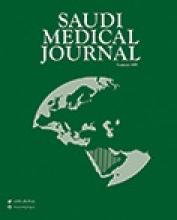Abstract
OBJECTIVE: To determine the frequency of renal artery stenosis (RAS) by performing routine renal angiography in a cohort of patients undergoing clinically indicated non-emergent coronary angiography. A secondary goal was to define potential variables which may predict RAS in this cohort.
METHODS: This was a prospective observational cross-sectional study whereby routine drive-by renal angiography was performed in 870 consecutive patients undergoing non-emergent coronary angiography at Queen Alia Heart Institute, Amman, Jordan during a 4-month period extending from January 2006 to April 2006. Patients were evaluated regarding the presence and severity of RAS. Renal artery stenosis has been defined as diameter stenosis >50% on conventional angiography. Univariate analysis and multivariate analysis were then performed to evaluate potential predictors for RAS.
RESULTS: Renal artery stenosis was found in 21 patients leading to a very low frequency of 2.4%. In univariate analysis, significant association with RAS was found with age, female gender, coronary artery disease severity, systolic blood pressure and creatinine clearance. In multivariate analysis, the only significant predictors were female gender (odds ratio 6.61, confidence interval 1.73-25.31, and p=0.006) and creatinine clearance in males (odds ratio 1.97, confidence interval 1.21-3.67, p=0.004).
CONCLUSION: Low frequency of RAS was noticed in our study. Performing drive-by renal angiography may be not justified in Jordanians except in high risk subgroups for RAS.
- Copyright: © Saudi Medical Journal
This is an open-access article distributed under the terms of the Creative Commons Attribution-Noncommercial-Share Alike 3.0 Unported, which permits unrestricted use, distribution, and reproduction in any medium, provided the original work is properly cited.






